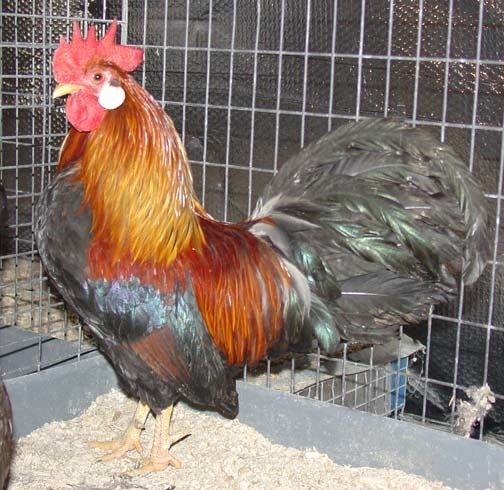Quote:
Nicalandia, when I look at the very old photograph, I note a couple of things. This is a black and white representation of an older Gold Legbar (not Cream) Cockerel that may have been slightly retouched (common form the time period). The description above the photo talks about the gold hackles and the bright chestnut of the wing coverts (wing bow and shoulder). So although the comment says that the photo doesn't look like there is color, I believe that it is because the photo is black and white. I do see a darker grey to the coverts which I think is the bright chestnut color. The lover chest appears darker gray which may be shadows or a truly darker color. The wing bay (triangle) look hidden by the saddle so I honestly cannot tell what color the wing triangle is on this cockerel.
I am confused because the SOP does call for :
Wings: Fronts and Bows—dark gray, faintly barred, some chestnut permissible.
Coverts—gray, barred, tipped in cream.
Primaries—dark gray, faintly barred, some white permissible.
Secondaries—dark gray, more clearly barred.
Please Note:I am not advocating whether chestnut is good or bad, or a non-colored wing-bay is good or bad, just trying to clarify what I am reading and solve a color puzzle :
It looks like the 'some chestnut permissible' could be for the entire wing and not restricted to the wing-bow/fronts only ( I say this because in the original article cited above it talks about the brilliant chestnut in the coverts in the Gold version thus logically they should still be present in the Cream version) although the clarification appears to say Fronts and Bows which makes me think only there is the Chestnut permitted. When I read the original description about the coverts, it makes me think that some chestnut would also be permissible in the wing-bay (triangle). So as I read this SOP, I am reading it that the wing triangle should be grey barred but wondering if it can be also barred with chestnut if we are to go to the original source?
I think the reason this is becoming important is that we go back to the original sources such as that shown above for guidance, and they may not match the SOP as it was written or perhaps re-written in Britain that we are carrying forward to our proposed SOP, and we need to decide what is important-the original sources and intent of Punnett or the contemporary SOP, or a blending of the two somehow?.
Looking at the two contemporary Leghorns Nicalandia has chosen for examples of the wing-bays being cream (white colored), the Leghorn being the root color of the wild type coloration for the Cream Legbar. Again looking at the SOP, the standard says secondaries-dark gray, more clearly barred., so the Cream Legbar ideal doesn't match the Leghorn examples. Why is that, it confuses me?
So in a nutshell, what is really vexing me is that the duckwing color (brown wing-bay/triangle) of the light brown legbar is getting diluted to cream(white) in the Cream Crele Legbar and the Cream Leghornr yet the SOP says grey barred. It is illogical that the gold in the duckwing would turn to grey when put a barring pattern over it (but would look white/cream when diluted), which is telling me that there is something else going on with the Cream Legbars that would have the base color be dark brown to black (crow wing) if you strip off the barring and the cream. Yet I thought that the Cream Legbars were based on the Light Brown Leghorn and would have a Partridge or Duckwing base. I am struggling with this as I clearly have a hole in my education and I would love to hear ideas from anyone to help me understand the genetics going on here!


 But I wanted to clarify that this is one of those British to American translations that had to be completed. In the APA, we are much more detailed and identify every part of the wing. The UK combines fronts, bows, and coverts together. So we actually had to observe several wings extended to figure out which part contained the "some chestnut smidges permissible" from the PCGB Standard. While I could see extending the "some chestnut permissible" to the Coverts section, should research prove it beneficial and accurate, adding it to the entire wing would not be staying with the confines of the existing standard. I am all for researching the original standard, along with historical descriptions from articles, but we must keep in mind that the APA Acceptance Committee will be comparing our standard to the current PCGB Standard for accuracy and validity.
But I wanted to clarify that this is one of those British to American translations that had to be completed. In the APA, we are much more detailed and identify every part of the wing. The UK combines fronts, bows, and coverts together. So we actually had to observe several wings extended to figure out which part contained the "some chestnut smidges permissible" from the PCGB Standard. While I could see extending the "some chestnut permissible" to the Coverts section, should research prove it beneficial and accurate, adding it to the entire wing would not be staying with the confines of the existing standard. I am all for researching the original standard, along with historical descriptions from articles, but we must keep in mind that the APA Acceptance Committee will be comparing our standard to the current PCGB Standard for accuracy and validity.


